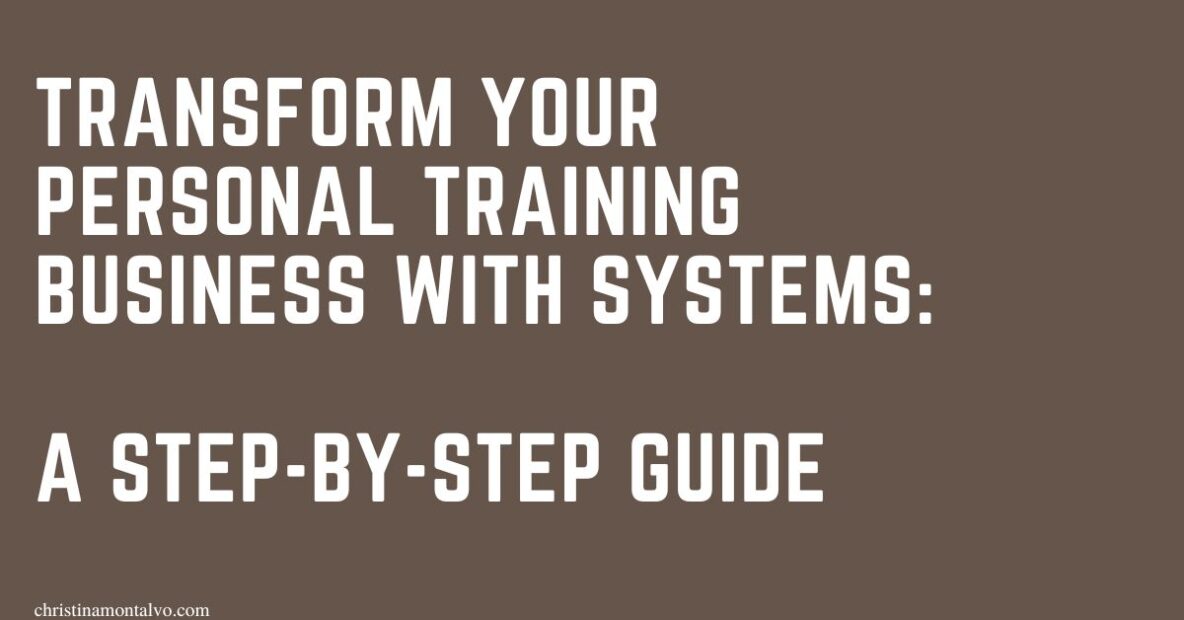Transform Your Personal Training Business with Systems: A Step-by-Step Guide
Imagine transforming the chaos of client inquiries and onboarding into a well-oiled machine that runs on autopilot. No more scrambling to find the right words or forgetting critical steps—just a seamless, stress-free process that saves time and impresses clients. How can you achieve this level of ease in your business? The answer is simple: systems.
What Are Systems?
A system is simply a way to ensure consistency in how tasks are handled. Think of it as a recipe you follow every time to guarantee the same result, whether it’s onboarding a new client, sending invoices, or creating content. By systemizing your business, you create step-by-step, repeatable processes that streamline your operations and free up your time to focus on what you do best—training clients.
Why Systemize Your Business?
- Consistency: Every client receives the same high-quality experience.
- Efficiency: Save time by reducing repetitive decision-making.
- Scalability: Easily handle more clients as your business grows.
- Stress Reduction: Eliminate the chaos of managing multiple tasks manually.
How to Systemize Your Personal Training Business
Systemizing your business may seem overwhelming at first, but breaking it down into manageable steps makes the process straightforward and actionable. Here’s how to begin:
Step 1: Brain Dump Your Repeating Tasks
Start by listing every single task you perform regularly in your business. This includes both client-facing and administrative duties.
Examples:
- Content creation
- Bookkeeping
- Client onboarding
- Client programming
- Invoicing/payment collection
- Newsletter creation
- Client off-boarding
- Client scheduling/rescheduling
Actionable Tip: Use a notebook or a digital document to jot down all these tasks without filtering. The goal is to capture everything you do routinely.
Step 2: Prioritize by Frequency
Next, organize your list based on how often each task occurs.
How To:
- Daily: Tasks you perform every day (e.g., client scheduling).
- Weekly: Tasks you handle once a week (e.g., content creation).
- Monthly: Tasks that happen once a month (e.g., bookkeeping).
Actionable Tip: Creating categories based on frequency helps identify which tasks consume the most time and should be prioritized for systemization.
Step 3: Rank by Energy Drain
Now, rank your tasks from most draining to least draining. This helps you understand which tasks are the most taxing and could benefit the most from a streamlined process.
How To:
- High Drain: Tasks that require significant mental or physical energy.
- Medium Drain: Tasks that are moderately challenging.
- Low Drain: Tasks that are easy and require minimal effort.
Actionable Tip: Focus on systemizing the high-drain tasks first to maximize your energy and efficiency gains.
Step 4: Identify Where to Begin
Compare your two lists—frequency and energy drain—to decide which task to systemize first. Ideally, start with tasks that are both frequent and energy-draining for the greatest impact.
Example:
- High Frequency & High Drain: Client scheduling.
- Low Frequency & High Drain: Bookkeeping.
Actionable Tip: Begin with tasks that recur often and drain your energy the most, as systemizing these will provide immediate relief and improve your daily workflow.
Example: Systemizing Client Onboarding
To illustrate how to systemize a specific part of your business, let’s delve into the client onboarding process. This is a crucial area where efficiency and professionalism can significantly enhance client experience.
Step 1: Define How Potential Clients Reach Out
Questions to Consider:
- Is there a form on your website?
- Do you use a Google Form?
- Do clients email you directly?
- Do you use a CRM platform?
Example:
- Process: Your website features a Google Form that acts as an initial screening tool.
- Form Questions:
- What are your fitness goals?
- How many sessions per week are you considering?
- Do you have any injuries or restrictions?
- Collect their name, email, and phone number.
Actionable Tip: Ensure the form includes fields for essential contact information and relevant questions to qualify leads.
Step 2: Create a Templated Email for Next Steps
Once a potential client submits the form, send an automated, templated email outlining the next steps.
Template Example:
Subject: Next Steps for Personal Training with [Your Name]
Hi [Client Name],
Thank you for filling out the inquiry form! Based on your responses, the next step is to [book a discovery call/movement screen/first session]. Please click the link below to schedule a time that works for you:
[Insert Scheduling Link]Let me know if you have any questions!
Best,
[Your Name]
Actionable Tip: Customize the template to fit your specific process and include a clear call-to-action with a scheduling link.
Step 3: Automate Scheduling
Use a scheduling tool to handle booking, reminders, and rescheduling automatically.
Recommended Tools:
- Calendly: Offers easy scheduling and integrates with various calendars.
- Acuity: Provides robust scheduling features and customization options.
Actionable Tip: Set up your booking calendar to send automatic reminders and offer rescheduling options to reduce no-shows and administrative workload.
Step 4: Post-Call Follow-Up
After the discovery call, send a follow-up email summarizing the conversation and outlining the next steps.
Template Example:
Subject: Summary of Our Call and Next Steps
Hi [Client Name],
It was great speaking with you today! Here’s a summary of what we discussed:
- Your fitness goals: [Goals]
- Proposed training plan: [Plan Details]
Next steps:
[Insert Payment Link]
- Review and sign the attached contract.
- Complete the waiver form.
- Submit the payment agreement using the link below:
Once these are completed, you can schedule your first training session here:
[Insert Scheduling Link]Let me know if you have any questions!
Best,
[Your Name]
Actionable Tip: Include all necessary documents and links in your follow-up email to streamline the onboarding process.
Step 5: Complete Onboarding
Once the client completes the previous steps, they are officially onboarded.
Process Overview:
- Client fills out Google Form → Form triggers email notification to you.
- Trainer sends templated email with booking link.
- Client books a discovery call → Call automatically sends reminders.
- Trainer sends post-call email with contract, payment link, and scheduling instructions.
- Client signs contract and schedules first session → Onboarding complete!
Visual Example:
Actionable Tip: Map out this workflow visually using a flowchart tool like Lucidchart or Canva to have a clear overview of your onboarding system.
Tools to Streamline Your Systems
Implementing systems is easier with the right tools. Here are some recommendations to help you automate and manage your processes effectively:
- Scheduling:
- Calendly
- Acuity
- Email Automation:
- Mailchimp
- ConvertKit
- HubSpot CRM
- Form Creation:
- Google Forms
- Typeform
- Workflow Automation:
- Zapier
- Integromat
- Document Management:
- Google Docs
- Notion
- Trello
Actionable Tip: Explore these tools and choose the ones that best fit your workflow and budget. Many offer free tiers or trials to get you started.
Start Small and Scale Up
Systemizing your business doesn’t happen overnight. It’s essential to start with one task and gradually build your systems. Here’s how to get started:
- Choose One Task: Select a task that is both frequent and draining. For example, client scheduling.
- Create a Step-by-Step Process: Define each step involved in the task.
- Implement Tools: Use scheduling software to automate the process.
- Create Templates: Develop email templates to ensure consistency.
- Test and Refine: Monitor the system’s effectiveness and make adjustments as needed.
Actionable Tip: Dedicate time each week to work on systemizing different aspects of your business. Celebrate small wins to stay motivated.
Start small: Choose one task from your list today and create a step-by-step process for it. Once you see how much time and energy it saves, you’ll want to systemize everything! By implementing systems in your personal training business, you not only enhance your efficiency but also provide a superior experience for your clients. Embrace the power of systems and watch your business thrive effortlessly.
Ready to get started? Begin by listing your repeating tasks and prioritize them based on frequency and energy drain. Take the first step towards a more organized and profitable personal training business today!


